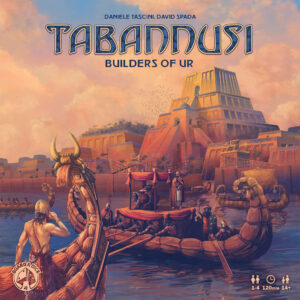 The “T” series of games started in 2012 with the release of T’zolk’in: The Mayan Calendar. Since that time, designer Daniele Tascini and several co-designers have embarked on a recurring thematic tableau linked by the same first letter. There was Teotihuacan: City of Gods in 2018. Then Trismegistus: The Ultimate Formula in 2019. Then Tekhenu: Obelisk of the Sun in 2020. Outside of the shared designer, another common thread is the use of a colon and descriptor to evoke the innovative central design element.
The “T” series of games started in 2012 with the release of T’zolk’in: The Mayan Calendar. Since that time, designer Daniele Tascini and several co-designers have embarked on a recurring thematic tableau linked by the same first letter. There was Teotihuacan: City of Gods in 2018. Then Trismegistus: The Ultimate Formula in 2019. Then Tekhenu: Obelisk of the Sun in 2020. Outside of the shared designer, another common thread is the use of a colon and descriptor to evoke the innovative central design element.
Based on the release timeline above, it was no surprise to see a new “T” series emerge in the year 2021. Tabannusi (which roughly translates to “build”) is followed by the evocative descriptor Builders of Ur. So, Build: Builders of Ur? Released by publisher Board & Dice, Tabannusi sees players navigating the ancient waterways, and in a wicked twist of fate, tasks them with building the city of Ur.
Gameplay Overview:
The main board features five areas distinguished by different colored barges where dice are rolled and placed based on player count. Three of these areas are districts related to the city of Ur and functionally work very similarly, whereas the other two (the ziggurat and the port) are unique. Players have both an architect and an assistant meeple. On a turn, players choose a single die from the barge in their current district, move their architect to the location based on the die value, and then use their assistant to take two actions before following to the new location.
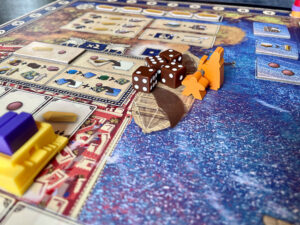
A chosen die is added to a player’s resource pool and effectively loses its value, becoming a resource of the die color. Each district’s building protocol uses a different resource color (white, yellow, brown) whereas green and blue dice, which are available in the ziggurat and port barges respectively, relate to garden and water tiles. Players also gain gold, which acts as a wild resource, as well as garden and water tiles via different placement options.
In the three city districts, players have the option of adding new project tiles. Project tiles are available in three colors (white, yellow, and brown) and can only be added one at a time to the board. Project tiles also have limitations based on location and size (max of three), though there can be a collaboration by multiple players. Players must also have claim markers to add to each project tile they place to indicate ownership. As claim markers are limited to fifteen total and each player starts with five, being mindful of this inventory is important.
When another player visits a district where a project tile has been placed, they now have the option to construct a building based on the number of project tiles in a single color. Each building requires the appropriate resources, and once constructed, any claim markers that were present are removed. If a player builds over their own project tile, they lose the claim marker to the general supply, whereas other players’ claim markers return to their usable supply. Players can move up a mastery track based on the color of the project tiles used, which increases potential mid- and end-game scoring.
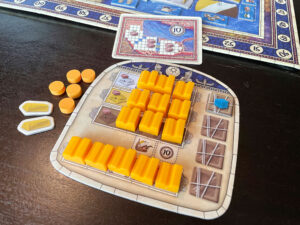
Players take turns moving their architect and taking a die and two actions. If not adding a project tile or constructing a building, they can use the green/blue dice taken from the other areas to add water and garden tiles to a district, effectively making an adjacent building more valuable by expanding its size. Gardens with a player’s claim marker also provide additional movement on the mastery track for buildings. Bonus actions are available that allow players to spend resources to flip used crate tiles (gained from the port) or score decree cards that are on display.
The ziggurat and port areas are unique as they provide specific scoring opportunities. With the ziggurat, players can add their houses to specific regions to boost scoring based on the tiles present, whereas in the port players are able to spend resources and/or gold to add houses and/or claim ships. Ships provide powerful special abilities to enhance actions and scoring.
Once all dice are selected from the barge, a scoring phase is triggered for the associated district. After this scoring, all dice of that color are returned to the central supply and rerolled before being readded to the barge. Any player who has a die of the specific color in their supply loses it and gains either a bump on a mastery track or a garden/water tile as compensation.
After five rounds are complete, all districts score a final time before end game scoring. The distance on each mastery track benefits players immensely in the final scoring. Players also assess a hidden objective called the urban card which they score if they were able to meet the conditions listed on it.
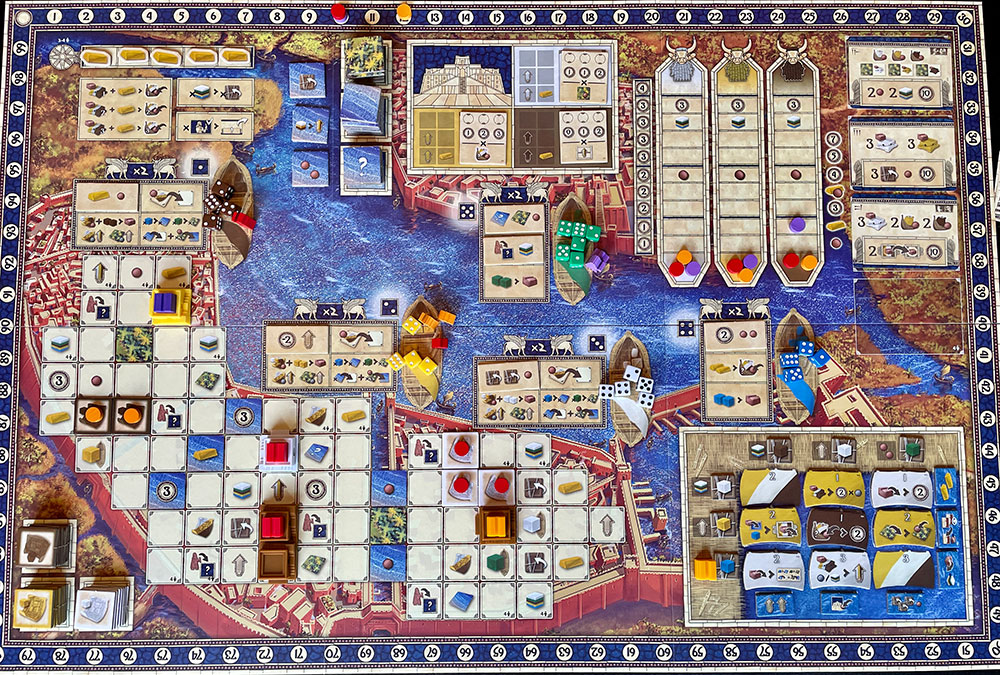
Game Experience:
Let’s face it, the central mechanic present in Tabannusi isn’t as engaging in a tactile way as the gears, pyramids, or obelisk in previous “T” series games. Sure, there are plastic building bases to erect and a double-sided main board with an attractive water display, but the initial hook isn’t as immediate. While it lacks this visual design cohesion, there is a lot to be said about the simple action selection mechanism that the five districts and two worker meeples present.
Each turn finds players weighing several possible routes, thinking multiple turns ahead, to be more efficient than opponents. Each barge’s options dwindle over time and resources are constantly shifting into infrastructure or scoring potential, thus providing a constant need to adapt to others. As such, this is a game that plays better with three or four at the table, to allow for project tiles to be built by opponents to enhance mastery track options.
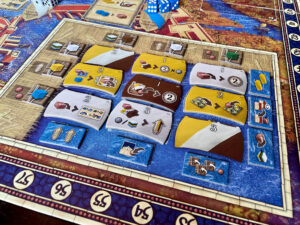
The game’s tempo is also quite deceptive. Upon entry, and based on previous games in the series, there’s a tendency to think this will overstay its welcome. Thankfully, Tabannusi simmers in the first round or two and ramps into a very swift end game at all player counts. The framework built around the dice removal from barges is excellent and pushes players to always keep their goals in mind. Trying to spread into multiple areas of the board may prove too punishing against seasoned Ur veterans.
Another great aspect is the shared project tile system. Having the opportunity to jump into a project with an opponent can provide great benefits. Also, being able to choose when and where to build based on this creates a lot of tension, especially as it’s cheaper to build an opponent’s project. As such, this is another reason why the game plays better at three and four. At two players, there isn’t as much tension around the building decisions and the system breaks down a bit. There may have been more that needed to be adjusted with player scaling to help with this.
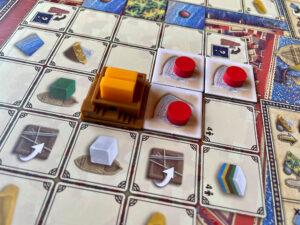
While the action system, as well as the available actions, are simple once you’ve taken the time to really learn them, the game of Tabannusi’s initial buy-in can be very rough as the ruleset is not as intuitive as it could’ve been. The system has one too many layers in several areas and with each new caveat comes a disconnect from a very shallow theme. Players must keep track of which die to take, then which decree cards to pursue, then which districts to build in, then which ship tiles to claim to boost their actions, and on and on. Based on the relatively swift game time (for this series), it feels like a few too many options were jammed in.
One of the best examples of this is the fifth district, the ziggurat. This action provides a pathway to points and provides some direction but stepping away from the building and port areas for small point bonuses and no real connection to the theme feels like a misstep, even if a fifth district was needed to make the dice action selection system work. I’ve walked away from each game wishing I didn’t have to consider this area, or that it was integrated into the system in a more satisfying way.
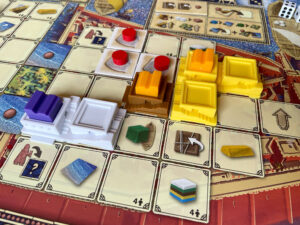
Another example of bloat is the decree options (I much prefer the hidden objective urban cards) as they feel like just another possible direction that the ziggurat was already trying to provide. They do provide much larger end-game goals, but they distract from the central theme. I also wonder if the port district could’ve used more attention to make the scoring feel more impactful, as players only score a small amount in this area. I’m sure this was to offset the powerful special abilities gained here, but again satisfaction of reaping some rewards from investment is minimized.
Final Thoughts:
A competent effort from a seasoned designer that treads familiar paths. There’s a lot to enjoy in Tabannusi: Builders of Ur. And for those who appreciate heavier strategy with tactical and spatial elements, this may be an entry that rewards repeated plays. Outside of the action selection and timing framework, a lot of the familiarity here doesn’t inspire a step forward for the series.
Tabannusi: Builders of Ur is more than competent, but the rules overhead and a continual shrug at certain areas makes me think this won’t see the table as often as some of its series brethren. I do hope that the action system finds its way into a different (and more immersive) theme in the future though. Maybe a “T” series game that reaches beyond the scope of history to provide us with something more ambitious, but at the same time streamlined, a future masterwork of design that the builders of the great city of Ur would be proud to witness.
Final Score: 3 stars – We built this city but in the end were faced with more rock than roll.
 Hits:
Hits:
• Action selection system
• Building decisions
• Tempo ramps nicely
• Constant adaptation
Misses:
• Convoluted ruleset
• Ziggurat action/scoring
• Bloated additions
• Uninspired components
Source: Board Game Quest





